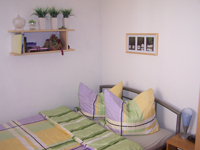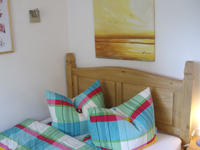Apartment Cologne presents: Worringen
Worringen has a total area of 11.73 km² and has approximately 9911 inhabitants. The district is the northernmost district of Chorweiler.

| District number | area | residents |
| 612 | 11.73 square kilometers | 10,000 |
Geographical location
Worringen is on the left bank of the Rhine. Roggendorf and Thenhoven are the neighbors west of Worringen. South of the district are Blumenberg , Fühlingen and Merkenich . In the north of Worringen, the city of Dormagen forms the border and in the east is Monheim am Rhein.
History of the district
The ancient world: The district was already populated 500 BC. The Eburons were the first settlers here. Around 20 BC the Uburons were followed by the Ubiers. After that, the settlers of the area around Worringen were the Romans. The Francs followed in about 355. Archaeological finds prove the existence of Roman estates. The Buruncum fort, however, cannot be proven. Over the centuries, today's wrestling had different spellings. Among others, the following are documented: Worunc, Worunch, Woronc, Woring, Woeringen and Wuring.
The Middle Ages: in 922 the district was first mentioned in a document. In 1151 it was a Count von Jülich who sold the Worringen Vogterei to the Dompropstei. Wilhelm von Holland, a count, became king of Germany on October 3, 1247. The Pankratiuskirche was built in the 12th and 13th centuries. However, the old church is no longer used as a church today. For centuries Worringen was the largest place in the Cologne area and Neuss. The inhabitants of the area were active in agriculture and in Rhine fishing.
They also trade with travelers. Some inns secured their existence as a result. The archbishop of Cologne erected a castle as the territorial lord. The place was of strategic importance. The battle of Worringen took place in 1288. Princes in the region, together with citizens of Cologne, defeated Archbishop Siegfried von Westerburg. The battle gave Düsseldorf city rights. But Cologne also became a free imperial city. However, it was not until 1475 that this status was granted. The winners of the battle caused the destruction of the Worringer castle. This was no longer built. In the Middle Ages, Worringen also had three city gates and a wall. However, Worringen did not receive city rights.
The French are coming
Modern times: 1794 was the year of the French revolutionary troops that occupied Worringen. The Mairie Worringen was built in 1796. Since 1798 it belonged to the canton of Zons. The Prussian mayor's office in Worringen was founded in 1815 and since 1816 it has belonged to the district of Cologne. Worringen, Weiler, Fühlingen, Langel, Roggendorf-Thenhoven and Merkenich were among them. Worringen was also the official residence of the mayor. Worringen got a town hall in 1908. 1922 was incorporated into Cologne. The citizens of Worring still don't feel that they belong to Cologne. Worringen has its own carnival. The carnival procession takes place on Rose Monday . In Cologne, however, the carnival parades take place on Saturday, Sunday or Tuesday. Many citizens of Worring work in the chemical industry, which is nearby.
The Mayors
Franz Adam Cremerius was the mayor of Worringen in 1797. The Pilgramshof and the Bergerhof belonged to him. In 1815 the district fell to the Kingdom of Prussia. Franz Adam Cremerius was mayor until 1835. He wanted to exchange land with Dormagen in 1819. He wanted to exchange the Rhine area up to the Piwipp house with the towns of Hackhausen and Hackenbroich. Cremerius was appointed Knight of the Red Eagle Order. He was 88 years old and died in 1852. Theodor Bollig was the first deputy of the Mayor's Office in Worringen. He was in office from 1832 to 1835. The next mayor was Heinrich Bender in 1866. He arranged for the relocation of the office from Worringen to Fühlingen. 8000 people gathered on the Rhine meadows during his tenure. Friedrich Engles and Ferdinand Lassalle gave speeches there. Bender died in 1883. He is buried in the cemetery in Rheinkassel. Matthias Bender was Mayor of Worringen for 41 years. Matthias Bender was the son of Heinrich Bender. This in turn moved the official business to Worringen.
Other offices
Also he was a local school inspector from Worringen and Thenhoven for 13 years. He was also the dike captain. Bender operated an acetylene gas plant between 1902 and 1911. The operation was stopped. A small train from Merkenich via Langel to Worringen, for which he campaigned, did not materialize. Bender donated a plot of land for a town hall building to the community. An administration was established during his tenure. This gave Bender a clerk, a construction official and a renter. As a pensioner, Matthias Bender made trips to Africa, the Orient and southern Europe. He died in 1917. Josef Seul was the last mayor of Worringen. His tenure lasted from 1907 to 1922. There was an increase in administrative staff. Josef Seul made sure that many streets were paved. Trenches were also channeled. In 1912 he conducted negotiations to locate Bayer AG. Bayer AG later settled. However, the plant was called Bayer Dormagen. The incorporation took place on April 1, 1922.
Religions
The Catholic parish church of St. Pancratius was built in 1837. In 1848 a large tower was added. By installing vaults and two rows of columns, the conversion to a three-aisled hall church was carried out in 1866. The previous church was converted into a school. The former long house was converted into a residential building. The old church tower still exists.
In 1961 the Evangelical Church of Peace was built. There is also a New Apostolic Church.
Leisure time
In the southwest of the district is the Worringer Bruch nature reserve. The residents of Worringen use it for hikes and walks. The Rhine meadows in the southeast are also used as a natural recreation area. An 18-hole golf course is located in Roggendorf. Cologne's public golf course has been located here since 1995.
Club life
Cultural
The local history of Worringen can be viewed in the Worringer Heimatarchiv (Breiter Wall 4). Photos, documents and objects are shown in exhibitions, thus presenting the local history.
Economy and infrastructure
Chemical plants are located between Dormagen and Worringen. Some of the facilities are located in Dormagen and some in Cologne. Ineos, a German branch of the chemical company, is located in Worringen. Worringen also has several small family businesses. The fields of the district experience agricultural use. In 1981 the small Worringer hospital was closed. A district hospital was built in Dormagen-Hackenbroich.
Traffic
The former Roman road connection from Cologne via Neuss to Xanten is still important today. Today it is the federal highway 9. The A 57 was built in 1965 to relieve the B 9. Worringen is well connected to the motorway network. A station was built in Worringen when the railway line from Cologne to Krefeld was built. Lines S 6 and S 11 connect Worringen with Cologne and Dormagen, Neuss, Düsseldorf, Ratingen and Essen. In Worringen there is also a bus connection to Cologne-Weidenpesch.
Education
Worringen has six kindergartens and two primary schools. The secondary school was closed in summer 2011. Secondary schools are visited in the other parts of Cologne as well as in Dormagen.
Born in Worringen ...
... is Josef Marxen. The Catholic priest is known as a martyr in Albania.
The former mayor Mathias Bender was made an honorary citizen on June 27, 1907.
Welcome to Cologne
So when you have packed your bags, we look forward to welcoming you to the metropolis on the Rhine. The Weihofen family! Your overnight stay in Cologne ! Your Ferienwohnung-Koeln.com






